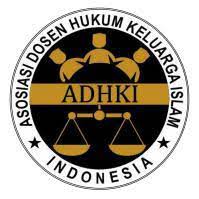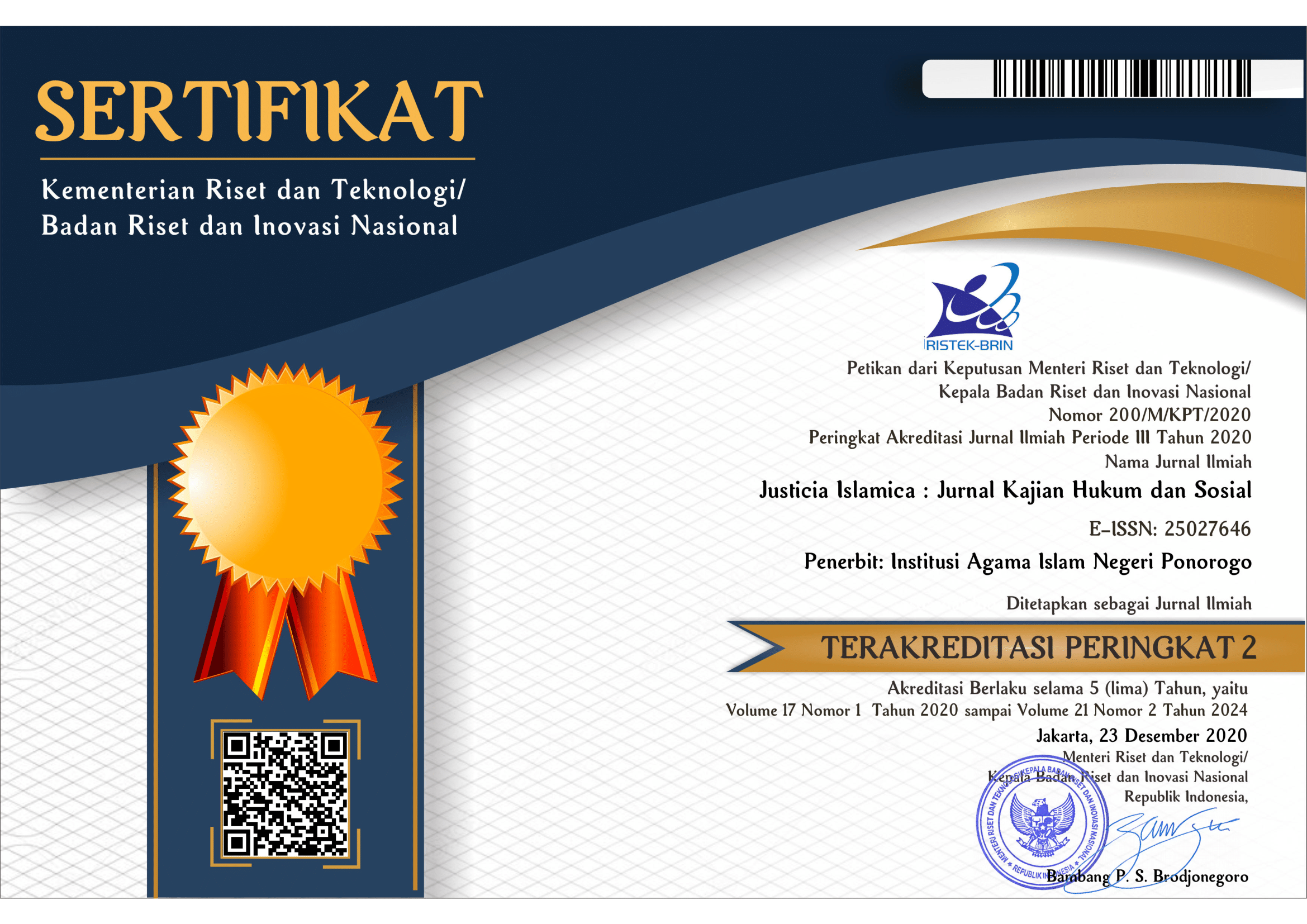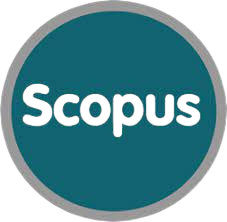Aligning Islamic Law and Customary Law: Legal Dialectics in the Tradition of Forced Marriage in Jambi
DOI:
https://doi.org/10.21154/justicia.v20i1.4720Keywords:
Custom, Dialectics, Islamic Law, Forced MarriageAbstract
This research will discuss the practice of forced marriage tradition by customary sanctions for returning home late at night in the Lekuk 50 Tumpi Lempur Jambi community. This research will also examine the interaction between Islamic law and customary law on the sanctions of the tradition. The research method used is field research. Data is collected by interviewing 16 informants, 7 couples, and two traditional leaders in Lekuk Lima Puluh Tumbi Lempur Jambi. Furthermore, the data that has been obtained is analyzed. So that the research results found that the interaction of Islamic law and customary law in the tradition of forced marriage in the Lekuk 50 Tumbi Lempur community, First, pre-marriage or imposition of sanctions, the nuances of Islamic law and custom go hand in hand. Second, the marriage contract procession is carried out with the Islamic religion, such as pillars and conditions. Third, post-contract, although the nuances of custom can be said to be more, it does not leave the nuances of religion. Theoretically, this research offers insight into the harmonious and complementary relationship between Islamic law and customary law, which is different because the two laws generally intersect. In addition, practically, this research reveals the practice of forced marriage carried out by custom, not from the family, which generally occurs
References
Abdelhafid, Hammouche. “Mariage Romantique, Mariage Planifié, Mariage Forcé: Un Enjeu Intergénérationnel En Situation Migratoire.” Dialogue 1 (2010): 47”“58. https://doi.org/10.3917/dia.187.0047.
Adly, Muhammad Amar, Nurcahaya, dan Muhammad Idris Nasution. “The Role of the Namora Natoras Mandailing Traditional Institutions in Forced Marriage in Affairs Cases.” Jurnal Mahkamah: Kajian Ilmu Hukum dan Hukum Islam 7, no. 1 (Juni 2022). https://doi.org/10.25217/jm.v7i1.2298.
Akhter, Naseem, dan Arshad Munir. “Forced Marriage in Pakistan (From Islamic Perspective).” Research Journal Al Basirah 5, no. 2 (2016).
Al-Asqalani, Al-Hafiz bin Hajar. Bulughul Maram. Semarang: Toha Putra, 2014.
Amalia, Novi Rizka. “Penerapan Konsep Maqashid Syariah Untuk Realisasi Identitas Politik Islam Di Indonesia.” Dauliyah 2, no. 1 (2017). http://dx.doi.org/10.21111/dauliyah.v2i1.806.
Amris, Kahar. Interviews with traditional leaders, 13 November 2017.
Anand, Ghansham, Xavier Nugraha, Dita Elvia Kusuma Putri, dan Angelina Regita Nathalia. “Forced Marriage as an Unlawful Act in Indonesia: A Comparative Analysis.” Lambung Mangkurat Law Journal 7, no. 2 (t.t.): 159”“74. https://doi.org/DOI: 10.32801/lamlaj.v7i2.353.
B. Interviews with perpetrators of forced marriages, 9 November 2017.
Darussamin, Zikri. Interaksi Hukum Islam dan Hukum Adat: Studi Pelaksanaan Kewarisan Masyarakat Melayu di Daerah Siak. Postgraduate Program UIN Sunan Kalijaga, 2003.
“Data Kantor KUA Lolo Gedang Kecamatan Pasar Kerman,” 2017.
E. Interviews with perpetrators of forced marriages, 7 November 2017.
Edwige, Rude-Antoine. “Mariage Forcé, Violence Physique, Violence Morale..., Une Réflexion À Partir De Jugements De Nullité De Mariage.” Cliniques Méditerranéennes 2 (2013): 45”“58. https://doi.org/10.3917/cm.088.0045.
Ertan, Senem, dan Fatma Yol. “Forced Marriage.” in The Palgrave Encyclopedia of Global Security Studies, disunting oleh Scott Romaniuk, Manish Thapa, dan Péter Marton, 1”“7. Cham: Springer International Publishing, 2019. https://doi.org/10.1007/978-3-319-74336-3_211-1.
G. Interviews with perpetrators of forced marriages, 9 November 2017.
Gunawan, Adam. “Pandangan Hukum Islam Terhadap Praktek Kawin Paksa (Study Kasus Di Desa Labuan Kecamatan Labuan Kabupaten Pandeglang.” Bachelor Thesis, UIN Sultan Maulana Hasanudin Banten, 2019.
Juliansyahzen, Muhammad Iqbal. “Dialektika Hukum Islam Dan Hukum Adat Pada Perkawinan Lelarian Di Lampung Timur.” Al-AḥwÄl 12, no. 1 (2019). http://dx.doi.org/10.14421/ahwal.2019.12101.
Kamsi. “Pergumulan Politik Hukum Perkawinan Islam Dan Adat di Indonesia.” Asy-Syir’ah: Jurnal Ilmu Syari’ah dan Hukum 46, no. 1 (Juli 2012). https://doi.org/10.14421/asy-syir’ah.2012.%x;
Liman, Ibrahim. Interviews with traditional leaders, 12 September 2017.
Lukito, Ratno. Islamic Law and Adat Encounter: The Experience of Indonesia. Jakarta: Logos, 2001.
____________. Tradisi Hukum Indonesia. Cianjur: IMR Press, 2012.
Minhaji, Akh. Islamic Law and Local Tradition; A Socio-Historical Approach. Yogyakarta: Kurnia Kalam Semesta Press, 2008.
Muhammad, Husein. Fiqh Perempuan: Refleksi Kiai atas Wacana Agama dan Gender. Yogyakarta: LKIS, 2001.
N. Interviews with perpetrators of forced marriages, 5 November 2017.
Nelda K. “Tinjauan Sosiologi Hukum Terhadap Nikah Paksa (Studi Kasus di Watang Sawitto Kabupaten Pinrang).” Bachelor Thesis, IAIN Pare-pare, 2018.
Psaila, Emma, Vanessa Leigh, Marilena Verbari, Sara Fiorentini, Virginia Dalla Pozza, dan Ana Gomez. Forced marriage from a gender perspective. European Union: Directorate General For Internal Policies, 2016. http://www.europarl.europa.eu/studies15.
R. Interviews with perpetrators of forced marriages, 5 November 2017.
Ramadani, Yolla, dan Astrid Qommaneeci. “Tradisi Wisuda Secara Adat di Masyarakat Lekuk Lima Puluh Tumbi Lempur Kabupaten Kerinci.” Jurnal Antropologi: Isu-Isu Sosial Budaya 22, no. 1 (Juni 2020). https://doi.org/10.25077/jantro.v22.n1.p29-37.2020.
Rodgers, Melisa A, Karla Mantilla, Angie Manzano, dan Megan Anne Nesper. “Yemen: Nine and ten-year-old girls forced into marriage, fight for divorce.” Off Our Backs 38, no. 1 (2008). http://dx.doi.org/10.2307/20838904.
Shabana, Ayman. Custom in Islamic Law, and Legal Theory; The Development of the Concepts of ”˜Urf and ”˜Ä€dah in The Islamic Legal Tradition. New York: Palgrave Macmillan, 2010.
Sucipto. “Urf Sebagai Metode Dan Sumber Penemuan Hukum Islam.” Asas 7, no. 1 (2015). https://doi.org/10.24042/asas.v7i1.1376.
Suta, I Wayan Bayu, I Nyoman Putu Budiartha, dan I Ketut Sukadana. “Keabsahan Perkawinan Ngerorod (Kawin Lari) di desa Kelusa, Kabupaten Gianyar.” Jurnal Interpretasi Hukum 2, no. 1 (2021). https://doi.org/10.22225/juinhum.2.1.3099.184-188.
Tanggu, Elsiati, Elly Esra Kudubun, dan Alvianto W Utomo. “Kawin Tangkap (Studi Sosiologi tentang Makna dan Praktik Kawin Tangkap di Desa Mareda Kalada, Kec. Wewewa Timur, Kab. Sumba Barat Daya.” Equalita: Jurnal Studi Gender dan Anak 3, no. 1 (2021). http://dx.doi.org/10.24235/equalita.v3i2.9841.
Toni, Irvan, dan Yulia. “Perkembangan Desa Wisata Lekuk Lima Puluh Tumbi Lempur Kabupaten Kerinci (2015-2020.” Galanggang Sejarah 3, no. 4 (Oktober 2021). https://ejournal.pamaaksara.org/index.php/gs/article/view/288.
W. Interviews with perpetrators of forced marriages, 5 November 2017.
Watson, Alan. Legal Transplants an Approach to Comparative Law. London: The University of Georgia Press, 1993.
Yasin, Nur. Hukum Perkawinan Islam Sasak. Malang: UIN Malang Press, 2008.
Yuliatin. Hukum Islam dan Hukum Adat: Studi Pengembangan harta Waris Masyarakat Seberang Kota Jambi. Yogyakarta: Program Pascasarjana UIN Sunan Kalijiga, 2014.
Zulqurnaini, Ahmad. “Pandangan Hukum Islam Terhadap Nikah Paksa Karena Titumbukne (Studi Kasus di Kec Mlarak).” Bachelor Thesis, IAIN Ponorogo, 2016.
Downloads
Published
Issue
Section
License
Requirements to be met by the author as follows:
- Author storing copyright and grant the journal right of first publication manuscripts simultaneously with licensed under the CC BY-SA allows others to share the work with a statement of the work's authorship and initial publication in this journal.
Authors can enter into the preparation of additional contractual separately for the non-exclusive distribution of a decadent version of the journal issue (e.g., post it to an institutional repository or publish it in a book), with the recognition of initial publication in this journal.
Authors are allowed and encouraged to post their work online (e.g., in institutional repositories or on their website) before and during the submission process because it can lead to productive exchanges and citations earlier and more severe than published works. (see The Effect of Open Access).
This work is licensed under CC BY-SA.


















